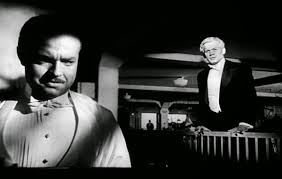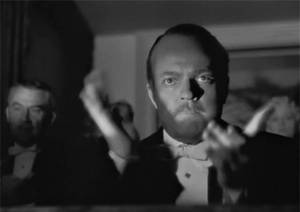Shadows can illicit a dark and gloomy mood in many cases. Horror films tend to use shadows to mask the murderer or shelter the monster. Generally, when the viewer sees a shadow they can expect something horrific to happen. In the iconic film Citizen Kane, shadows are used in a slightly different way. In Citizen Kane shadows are used to hide the identity of the reporter, Jerry Thompson, and reflect the actions of the main character, Charles Kane.
In the first scene that Thompson is introduced his face is hidden by shadows. The first scene after the “News March” shows the reporters in a room with harsh backlighting. Light is streaming through the windows in the back of the room causing the figures that the audience soon learns are reporters to be shown as silhouettes. Throughout the film Thompson is kept in the shadows and the background of the events that are going on. The key light is always focused on the person that Thompson is interviewing. When Thompson interviews Susan, Leland, Mr. Bernstein, and the Butler Raymond his back is turned and he is kept in the shadows. Thompson is even kept in the shadows when he is reading through Mr. Thatcher’s memoirs, a scene with somewhat similar lighting to the first reporter scene. Beams of light stream through high windows in the bank causing top lighting.
The only moment that Mr. Thompson is not completely immersed in shadows, and the viewer still does not get a clear view of his face, is at the end of the film when he is leaving Xanadu. The other reporters are questioning Thompson about what Rosebud is and he leaves them all with a stirring speech about how Kane cannot be summed up by one word. This brief moment of Thompson walking into the light for the first time suggests that he finally reached a moment of clarity about Kane and the story he is assigned to report on. Throughout the entire film he is kept in the shadows, literally and figuratively, about the mystery of Kane’s life. Thompson was also kept in the shadows to keep the emphasis of the story on Kane, implying that Thompson is not essential to the story.
Shadows are also used in the film to reflect the actions of Kane. In the majority of the shots of Kane his face is fully light, with few traces of shadows. However, at certain crucial points of the film, Kane’s face is masked in shadow. When Kane purchases the Inquirer one of the first things he does is tell Leland and his staff that he will be an honest journalist and then signs the Declaration of Principles. As he is signing the Declaration his face is covered in shadow. The Declaration represented the standard that Kane promised to uphold while he ran the newspaper and as the movie progresses Kane’s attitude and personality become more despicable, straying further from the moral standard he wanted to embody. It is clear that his loved ones, specifically his close friend Leland, believe that he has lost his morals when he sends him the Declaration in the mail. Kane’s face covered in shadow while he signs the paper may foreshadow the darkness and greed of his personality that would soon come to light.
Kane is also in the shadows when Emily finds out about Susan. This scene highlights Kane’s moral compass spiraling out of control. This was, of course, what caused Kane to lose the governor race. These shadowed scenes coincide with moments of poor moral action and opinion. In the scene when Kane is writing up a bad review about Susan his face is in partial shadows signifying that he could make a moral choice; he could be honest in the review or he could lie and say that she was fantastic. When he actually goes to watch her performance he gives her a standing ovation at the end but he is alone and again, in shadows.
Orson Welles utilizes light and shadow throughout the film to convey meaning beyond mere aesthetics. The use of shadows in the film suggest themes of immorality, loneliness, and insignificance while the use of light can portray clarity and morality.



